Scratch Thundercloud Original Design / Scratch Built
Scratch - Thundercloud {Scratch}
Contributed by Roger Lipke
| Manufacturer: | Scratch |
(Contributed - by Roger Lipke)
Note: This is a slightly edited version of Roger's information with fewer pictures. Visit Roger's site for many more pictures and flight data graphs.
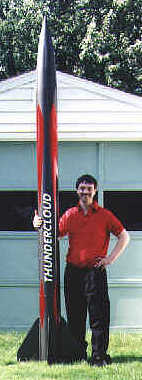 "Thundercloud" is a 7.67" diameter High Power Rocket.
It stands about 10-1/2 feet tall and weighs approximately 30 lbs empty. The
airframe is Public Missiles craft-phenolic, the fins are 1/4 plywood, and the
nose is carbon fiber.
"Thundercloud" is a 7.67" diameter High Power Rocket.
It stands about 10-1/2 feet tall and weighs approximately 30 lbs empty. The
airframe is Public Missiles craft-phenolic, the fins are 1/4 plywood, and the
nose is carbon fiber.
It has one 54mm central motor mount, and two canted 38mm outboards.
The really unique thing about this rocket is its rear-ejection recovery system. One 36" drogue and three 66" main chutes are housed in four rear-facing 54mm tubes. Special caps hold the chutes and shock chords in under acceleration. When the ejection charge pressurizes the tube, a piston in the cap retracts retaining pins, and allows the chutes to deploy.
There are several advantages to this system. The rocket stays in one piece for the entire flight which means there is no chance of drag separation or a tendency to bend at a slip-joint. Also, if the rocket should land in a tree, the 40 foot lines will allow the rocket to fall through the tree with only the chutes themselves getting hung up.
The disadvantages include extra weight in the rear of the rocket. If no payload is being used, ballast must be added to the nose. Another disadvantage is the complexity, but that's what makes it cool :)
The recovery system is activated primarily by an Adept RAS2-50K recording altimeter. This triggers the drogue chute at apogee and the mains at 750' above ground level. It also records the altitude and time of flight taking ten samples per second for 96 seconds.
Backing up the Adept and providing additional data is the Emmanuel Avionics Accelerometer. This is also programmed to fire a drogue at apogee, but the mains are programmable to any altitude as read by its own separate barometric sensor. It records 320 samples of time, acceleration, velocity, and altitude.
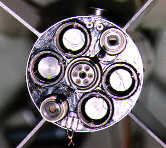 I have flown the rocket three
times and it performed beautifully every time. The last flight reached an
altitude of 3000' on a K1100 and two J350's. The next time it will fly on a
K1050 and two J350's and should soar well over 4000'.
I have flown the rocket three
times and it performed beautifully every time. The last flight reached an
altitude of 3000' on a K1100 and two J350's. The next time it will fly on a
K1050 and two J350's and should soar well over 4000'.
Two weeks before the launch, the rocket was assembled in my back yard for measurements. Here are the results:
| Weight Empty (less motors): | 28 lbs |
| Center of Gravity Empty | 48.5" from rear of tube |
| Weight Loaded | 34 lbs |
| CG Loaded | 40.6" |
| Diameter | 7.67" |
| Over All Length | 124.56" |
| CP (from VCP) | 25.3" |
| Stability factor | 2.0 Calibers |
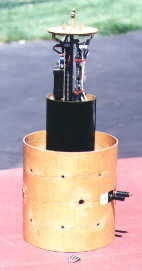 This is the electronics
section for the Thundercloud. It also doubles as the coupler connecting
the two four foot sections of body tube. The four inch round tube houses
an Adept RAS2-50K recording altimeter and an Emmanuel Avionics
accelerometer. the electronics are mounted to a 1/4" phenolic board
that rides up and down in U-channel guides. A ball-plunger detent
mechanism holds the electronics 'drawer' in the open position. Brass
screws at the top provide contacts for attaching leads from ejection
charges.
This is the electronics
section for the Thundercloud. It also doubles as the coupler connecting
the two four foot sections of body tube. The four inch round tube houses
an Adept RAS2-50K recording altimeter and an Emmanuel Avionics
accelerometer. the electronics are mounted to a 1/4" phenolic board
that rides up and down in U-channel guides. A ball-plunger detent
mechanism holds the electronics 'drawer' in the open position. Brass
screws at the top provide contacts for attaching leads from ejection
charges.
The four inch tube is supported by two 1/2" tubes crossing in the center and extending flush to the outside of the airframe. These supports double as static ports or 'vents' for the barometric pressure altimeters. Power and arming jacks are accessible from the outside of the rocket and are activated after the rocket is positioned on the launcher.
Flight #3 - Accelerometer Data Summary
Length of flight path to apogee: 3141 feet
Maximum Velocity: 318 mph / 467 ft/sec
Maximum Acceleration: 12.16 g @ 1.1 sec
Minimum Acceleration: -1.78 g @ 3.6 sec (burnout), -2.3 g @ 16 sec
(drogue deployment)
Launch Rail Velocity: 40 mph / 59 ft/sec
Flight #3 - Altimeter Data Summary
Peak Altitude: 2997 feet
Decent Rate under Drogue: 62 ft/sec / 42 mph
Decent Rate under Main: 22 ft/sec / 15 mph
Time of Flight: 84 seconds
Discussion:
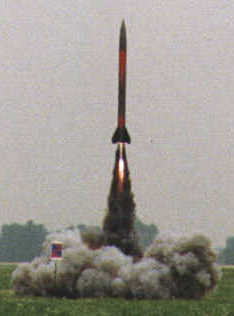 It left the pad at about 4
g's with the K1100. About one second into the flight the two J350's hit and it
jumped to an instant 12 g's! I was surprised to see two J350's provide way more
thrust for the first half second than a K1100.
It left the pad at about 4
g's with the K1100. About one second into the flight the two J350's hit and it
jumped to an instant 12 g's! I was surprised to see two J350's provide way more
thrust for the first half second than a K1100.
It reached a top speed of 318 mph at 2.68 seconds (burnout) and 604' (burnout altitude).
It reached apogee at about 14 seconds. It fell at 62 ft/sec under the 36" drogue chute until the mains hit at 53 seconds (750') which slowed it to 22 ft/sec. Touchdown was at 84 seconds.
Flight #4 - Accelerometer Data Summary
Length of flight path to apogee: 3856 feet
Maximum Velocity: 356 mph / 522 ft/sec
Maximum Acceleration: 6.3 g @ 0.2 sec , 6.3g @ 2.3 sec
Minimum Acceleration: -2.0 g @ 5.0 sec (burnout), -4.1 g @ 17 sec
(drogue deployment)
Launch Rail Velocity: 40 mph / 59 ft/sec
Flight #4 - Altimeter Data Summary
Peak Altitude: 3692 feet
Decent Rate under Drogue: 67.5 ft/sec / 46 mph
Decent Rate under Main: 18.0 ft/sec / 12 mph
Time of Flight: 98 seconds
Discussion:
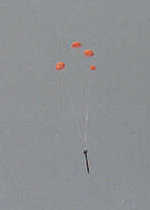 It left the pad at about 6
g's with the two regressively burning J350's. Just as the J350's are burning
out, the center K1050 ignites and once again the rocket is pulling 6 g's.
It left the pad at about 6
g's with the two regressively burning J350's. Just as the J350's are burning
out, the center K1050 ignites and once again the rocket is pulling 6 g's.
It reached a top speed of 356 mph at 4.6 seconds (burnout) and 1164' (burnout altitude).
It reached apogee at about 16 seconds. It fell at 67.5 ft/sec under the slightly reefed 36" drogue chute until the mains hit at 63 seconds (750') which slowed it to 18 ft/sec. Touchdown was at 98 seconds landing only a couple hundred feet from the launcher.
Sponsored Ads
 |
 |











